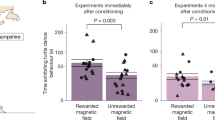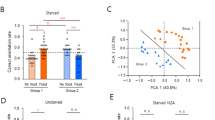Abstract
Some vertebrates can navigate over long distances using the Earth's magnetic field, but the sensory system that they use to do so has remained a mystery. Here we describe the key components of a magnetic sense underpinning this navigational ability in a single species, the rainbow trout ( Oncorhynchus mykiss). We report behavioural and electrophysiological responses to magnetic fields and identify an area in the nose of the trout where candidate magnetoreceptor cells are located. We have tracked the sensory pathway from these newly identified candidate magnetoreceptor cells to the brain and associated the system with a learned response to magnetic fields.
This is a preview of subscription content, access via your institution
Access options
Subscribe to this journal
Receive 51 print issues and online access
$199.00 per year
only $3.90 per issue
Buy this article
- Purchase on SpringerLink
- Instant access to full article PDF
Prices may be subject to local taxes which are calculated during checkout






Similar content being viewed by others
References
Wiltschko, R. & Wiltschko, W. Magnetic Orientation in Animals(Springer, Berlin, (1995)).
Leask, M. J. M. Aphysicochemical mechanism for magnetic field detection by migratory birds and homing pigeons. Nature 267, 144–145 (1977).
Phillips, J. B. & Borland, S. C. Behavioural evidence for use of a light-dependent magnetoreception mechanism in a vertebrate. Nature 359, 142–144 (1992).
Kalmijn, A. J. Biophysics of geomagnetic field detection. IEEE Trans. Magn. 17, 1113–1124 (1981).
Gould, J. L., Kirschvink, J. L. & Deffeyes, K. D. Bees have magnetic remanence. Science 201, 1026–1028 (1978).
Walcott, C., Gould, J. L. & Kirschvink, J. L. Pigeons have magnets. Science 205, 1027–1029 (1979).
Lohmann, K. J. & Lohmann, C. M. F. Detection of magnetic field intensity by sea turtles. Nature 380, 59–61 (1996).
Quinn, T. P., Merrill, R. T. & Brannon, E. L. Magnetic field detection in sockeye salmon. J. Exp. Zool. 217, 137–142 (1981).
Lohmann, K. J. et al . Magnetic orientation of spiny lobsters in the ocean: Experiments with undersea coil systems. J. Exp. Biol. 198, 2041–2048 (1995).
Kirschvink, J. L. & Gould, J. L. Biogenic magnetite as a basis for magnetic field detection in animals. Biosystems 13, 181–201 (1981).
Yorke, E. D. Apossible magnetic transducer in birds. J. Theor. Biol. 89, 533–537 (1979).
Walker, M. M. & Bitterman, M. E. Attached magnets disrupt magnetic field discrimination by honeybees. J. Exp. Biol. 141, 447–451 (1989).
Wiltschko, W., Munro, U., Beason, R. C., Ford, H. & Wiltschko, R. Amagnetic pulse leads to a temporary deflection in the orientation of migratory birds. Experientia 50, 697–700 (1994).
Beason, R. C., Dussourd, N. & Deutschlandeer, M. E. Behavioural evidence for the use of magnetic material in magnetoreception by a migratory bird. J. Exp. Biol. 198, 141–146 (1995).
Kreithen, M. L. & Keeton, W. T. Attempts to condition homing pigeons to magnetic stimuli. J. Comp. Physiol A 91, 355–362 (1974).
Woodard, W. T. & Bitterman, M. E. Adiscrete trials/fixed-interval method of discrimination training. Behav. Res. Meth. Instr. 6, 389–392 (1974).
Mann, S., Sparks, N. H. C., Walker, M. M. & Kirschvink, J. L. Ultrastructure, morphology and organization of biogenic magnetite from sockeye salmon, Oncorhynchus nerka : Implications for magnetoreception. J. Exp. Biol. 140, 35–49 (1988).
Walker, M. M. Learned magnetic field discrimination in the yellowfin tuna, Thunnus albacares . J. Comp. Physiol. A 155, 673–679 (1984).
Walker, M. M. & Bitterman, M. E. Conditioned responding to magnetic fields by honeybees. J. Comp. Physiol. A 157, 67–71 (1985).
Walker, M. M., Baird, D. L. & Bitterman, M. E. Failure of stationary but not of flying honeybees to respond to magnetic field stimuli. J. Comp. Psychol. 103, 62–69 (1989).
Carman, G. J., Walker, M. M. & Lee, A. K. Attempts to demonstrate magnetic discrimination by homing pigeons in flight. Anim. Learn. Behav. 15, 124–129 (1987).
Kirschvink, J. L. Magnetite biomineralization and geomagnetic sensitivity in animals: An update and recommendations for future study. Bioelectromagnetics 10, 239–259 (1989).
Moore, A., Freake, S. M. & Thomas, I. M. Magnetic particles in the lateral line of the Atlantic salmon ( Salmo salar L). Phil. Trans. R. Soc. Lond. B 329, 11–15 (1990).
Puzdrowski, R. L. Afferent projections of the trigeminal nerve in the goldfish, Carassius auratus . J. Morphol. 198, 131–147 (1988).
Blakemore, R. P. Magnetotactic bacteria. Science 190, 377–379 (1975).
Semm, P. & Beason, R. C. Responses to small magnetic field variations by the trigeminal system of the bobolink. Brain Res. Bull. 25, 735–740 (1990).
Beason, R. C. & Semm, P. Does the avian opthalmic nerve carry magnetic navigational information? J. Exp. Biol. 199, 1241–1244 (1996).
Walker, M. M. & Bitterman, M. E. Honeybees can be trained to respond to very small changes in geomagnetic field intensity. J. Exp. Biol. 145, 489–494 (1989).
Walcott, C. Magnetic orientation in homing pigeons. IEEE Trans. Magn. Mag-16, 1008–1013 (1980).
Kirschvink, J. L., Dizon, A. E. & Westphal, J. A. Evidence from strandings for geomagnetic sensitivity in cetaceans. J. Exp. Biol. 120, 1–24 (1986).
Walker, M., Kirschvink, J. L., Ahmed, G. & Dizon, A. E. Fin whales ( Balaenoptera physalus) avoid geomagnetic gradients during migration. J. Exp. Biol. 171, 67–78 (1992).
Kirschvink, J. L. & Walker, M. M. in Magnetite Biomineralization and Magnetoreception by Living Organisms: A New Biomagnetism(eds Kirschvink, J. L., Jones, D. S. & MacFadden, B. J.) 243–254 (Plenum, New York, (1985)).
Benvenuti, S. & Walraff, H. G. Pigeon navigation: site simulation by means of atmospheric odours. J. Comp. Physiol. A 156, 737–746 (1985).
Papi, F. Pigeons use olfactory cues to navigate. Ethol. Ecol. Evol. 1, 219–231 (1989).
Wallraff, H. G. Relevance of atmospheric odours and geomagnetic field to pigeon navigation: what is the “map” basis? Comp. Biochem. Physiol. A 76, 643–663 (1983).
Sidman, M. Tactics of Scientific Research: Evaluating Experimental Data in Psychology.(Basic Books, New York, (1960)).
Moench, T. T. & Konetzka, W. A. Anovel method for the isolation and study of a magnetotactic bacterium. Arch. Microbiol. 119, 203–212 (1978).
Acknowledgements
We thank the Whitehall Foundation, Marsden Fund, New Zealand Lotteries Grants Board, Auckland University Research Committee and School of Biological Sciences for support; W. T. M. Gruijters, B. M. Davy, I. MacDonald, V. Ward, A. Young and A. Cantell for technical assistance; and M. E. Bitterman, A. R. Bellamy and G. G. Dodson for helpful comments on earlier drafts of the manuscript.
Author information
Authors and Affiliations
Author notes
Correspondence and requests for materials should be addressed to M.M.W.
Corresponding author
Rights and permissions
About this article
Cite this article
Walker, M., Diebel, C., Haugh, C. et al. Structure and function of the vertebrate magnetic sense. Nature 390, 371–376 (1997). https://doi.org/10.1038/37057
Received:
Accepted:
Issue Date:
DOI: https://doi.org/10.1038/37057
This article is cited by
-
Prussian blue technique is prone to yield false negative results in magnetoreception research
Scientific Reports (2022)
-
A review of marine stressors impacting Atlantic salmon Salmo salar, with an assessment of the major threats to English stocks
Reviews in Fish Biology and Fisheries (2022)
-
Magnetoreception and magnetic navigation in fishes: a half century of discovery
Journal of Comparative Physiology A (2022)
-
Electrophysiology and the magnetic sense: a guide to best practice
Journal of Comparative Physiology A (2022)
-
The migration of four salmonid species through fish bypass channels depending on environmental factors
Environmental Biology of Fishes (2022)



